A hyggelig weekend in Copenhagen
In the last few years, I have visited Copenhagen several times and in a rather quick succession, albeit for only a couple of days each time (usually a long weekend). On the one hand, I wanted to follow in the footsteps of the protagonists of the Danish TV series ‘The Bridge’ (‘Bron/Broen’) (actually a Danish-Swedish co-production), ‘The Killing’ (‘Forbrydelsen’), and ‘Borgen’. On the other hand, I wanted to experience hygge.
Defined as ‘the practice of creating cozy and congenial environments that promote emotional well-being’, hygge is regarded as a defining characteristic of Danish culture, even though the word actually originates from a Norwegian word meaning wellbeing.
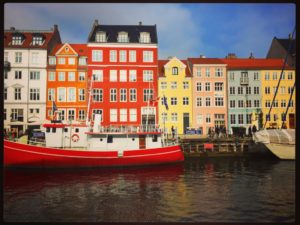
I remember walking (a lot) around the city and rather than focus on the must-sees and the must-visits, I ventured out of the city center to the adjacent neighborhoods (mostly Vesterbro and Nørrebro). Foodie as I am, I came across some great places to eat (and drink).
In general, I find that walking is the best way to explore a city (at least in Europe), soak up the atmosphere, and at the same time burn those calories. Copenhagen is no exception. In fact, having a population of around a million (depending on whether one refers to the Municipality or the urban area of Copenhagen), the Danish capital is relatively small (compared to most European capitals). Weather permitting, Copenhagen is a very walkable city, so put a pair of comfortable shoes on, and follow in my footsteps, as I’m retracing a hyggelig weekend there…
Friday:
A Danish meal at Øl & Brød
I first arrived in Copenhagen late on a Friday evening. I stayed at a hotel in Vesterbro, an up-and-coming neighborhood within walking distance from Central Station. Hungry as I was, I went straight to Øl & Brød for my first experience of the Danish cuisine. Located very close to my hotel (Viktoriagade 6), this is a cozy restaurant specializing in traditional Danish rather than New Nordic cuisine. The Mikkeller Bar is conveniently located literally next door to Øl & Brød (Viktoriagade 8). This bar is part of the Danish chain serving locally-brewed draft beers in Copenhagen, as well as around the world.
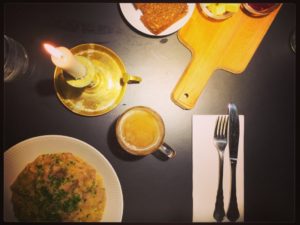
A Nordic Daiquiri at 1656 Cocktail Bar
To finish off the day, I headed to the nearby 1656 Cocktail Bar (Gasværksvej 33). This is a hidden speakeasy, located near the border with the Meatpacking District (Kødbyen). In case you’re wondering about the origins of the name, 1656 is the area code, as the bartender pointed out to me whilst I was waiting for my Nordic Daiquiri (homemade rhubarb compote, paired with raw licorice, and mixed with white rum and fresh lime).
Saturday:
A hyggelig breakfast at Mad & Kaffe & a late morning walk from Vesterbro to Nyhavn
I kicked off my day with breakfast at the Mad & Kaffe (Sønder Blvd. 68). This is a cozy (or should I say hyggelig) corner café-restaurant serving breakfast, lunch and dinner (Mad & Kaffe translates as ‘Food & Coffee’ in English). They have three locations around the city: this one in Vesterbro, as well as one in Frederiksberg and another one in Amagerbro.
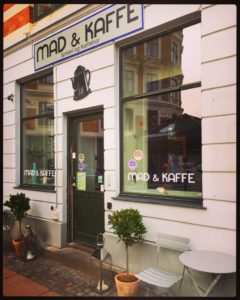
I then made my way towards the city center. Walking past the Central Station and the Tivoli Gardens, I found myself at the City Hall Square (Rådhuspladsen). From there, I walked on Strøget, one of the longest pedestrian shopping streets in Europe, up until Kongens Nytorv (‘The King’s New Square’) and the very instagrammable Nyhavn (‘New Harbour’). Lined with brightly-colored buildings, this waterfront location is perhaps the most characteristic part of the city.
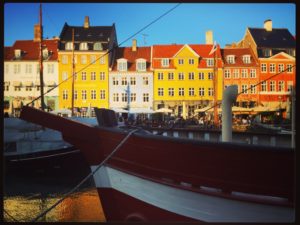
Smørrebrød at Ida Davidsen & an afternoon walk from Nyhavn to the Little Mermaid
From Nyhavn, I walked to Ida Davidsen, a small restaurant renowned for the smørrebrød: open sandwiches served on rye bread, topped with anything from fish to meat to vegetables. This is a great place for a light but typical Danish lunch, open Monday to Friday from 10:30 to 17:00. To avoid disappointment I made a reservation, and I would suggest you do the same. And, if you like it as much as I did, please thank my mother who had recommended it to me (Store Kongensgade 70).
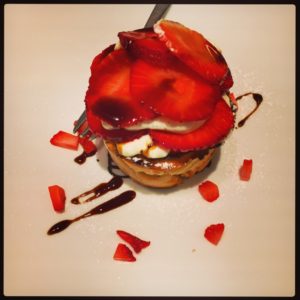
After lunch, I visited Frederik’s Church (Frederiks Kirke), also known as Marble Church, and then walked past Amalienborg, the home of the Queen Margrethe II and the Danish royal family. One of the city’s landmarks, the Royal Danish Opera House is located just across the water. My walk continued to St Alban’s Church (Churchillparken 11), and from there past Kastellet, a star-shaped fortress, to the Little Mermaid. Sitting on a rock by the waterside, this small yet iconic bronze statue by Edvard Eriksen has been a major tourist attraction since 1913, as well as a popular target for vandalism and defacement.
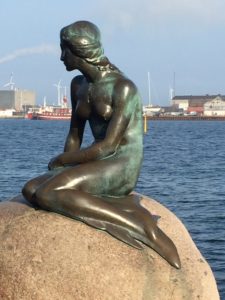
The Borgen & a coffee at the Paludan Bog & Café
Once I took a few photos of the Little Mermaid, I made a U-turn and went back to the city center, stopping to admire the Christiansborg Palace, colloquially known as ‘Borgen’. This historical building serves as the seat of the Danish Parliament, the Danish Prime Minister’s Office, and the Supreme Court of Denmark, and is home to the three supreme powers: the legislative power, the executive power, and the judicial power, respectively. This makes it the only building in the world that houses all three of a country’s branches of government.
A short walk from there is the Paludan Bog & Café, one of my favorite cafés and perfect pitstop for an afternoon dose of caffeine (Fiolstræde 10). Located in the old Jewish quarter and among University buildings, it is a popular student hangout. Known as Denmark’s oldest book café, it actually started as a bookstore that provided the students with affordable books, before the opening of the café. Here you can also enjoy a light meal at student- (or traveler-) friendly prices.
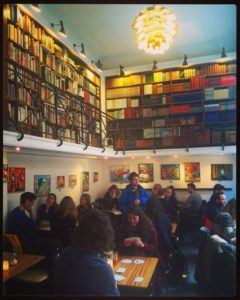
Fine (surprise) dining at Relæ
Located on a hip street in Nørrebro, Relæ is where I had my first experience of New Nordic fine dining (Jægersborggade 41). This minimalistic Michelin-starred restaurant was recommended as an alternative to Noma, which was temporarily closed at the time. The menu at Relæ is always a surprise to the patrons, for it changes daily and is never announced beforehand. The cuisine is highly innovative and even though it did not please my friends, it was an experience I would highly recommend (unless, of course, you’re on a budget, in which case you may want to give Relæ a miss).
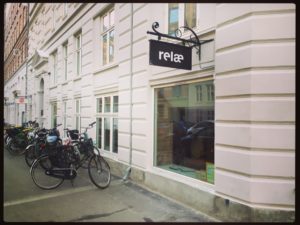
Gelato at Siciliansk Is
To finish off my meal on a sweet note, I headed to the nearby Siciliansk is (‘Sicilian Ice Cream’) for some Italian gelato (Rantzausgade 56). There have two locations, this one in Nørrebro, and another one in Vesterbro (Skydebanegade 3).
A pint (or two) at Ølsnedkeren
I absolutely love visiting Scandinavia in June when the days are so long that the daylight seems to last forever. This, of course, makes me reluctant to call it a day, so I am always on the lookout for a place to visit. On this occasion, I was looking for a bar, so I ended up having craft beer at the hipster Ølsnedkeren. With a name that translates as ‘the beer carpenter’ in English, this is a microbrewery and bar -also- located in Nørrebro (Griffenfeldsgade 52).
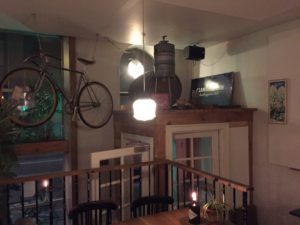
The Aquanaut at Ruby
Afterwards, on my way towards Vesterbro and my hotel, I decided to have one more drink, a cocktail this time. I had the Aquanaut: Plymouth gin, Taffel Akvavit, tarragon, sugar and lemon juice. Located just across the water from the Borgen, Ruby has been described as the cocktail crown jewel of Copenhagen (Nybrogade 10). Enough said.
Sunday:
Brunch at the Union Kitchen
The Union Kitchen is a café-restaurant really close to Nyhavn (Store Strandstræde 21). It is the perfect place for brunch to kick off the day. I had rye bread with avocado, and organic poached eggs. Next door, there is a prohibition-style cocktail bar bearing almost the same name as the restaurant: the Union Local (Store Strandstræde 16).
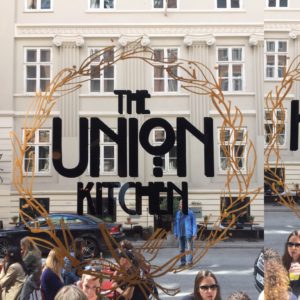
A visit to the Cathedral & an espresso martini at the Living Room
Afterwards, I visited the Copenhagen Cathedral (Vor Frue Kirke), also known as the Church of Our Lady. This is where Frederik, Crown Prince of Denmark, and Mary Elizabeth Donaldson got married in 2004. Afterwards, I headed to the nearby Living Room -another hyggelig cafe- for my caffeine fix (Larsbjørnsstræde 17). Since they serve cocktails (as well as hot drinks), I had an espresso martini.
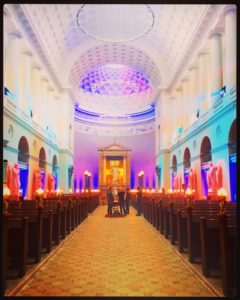
The last supper in Copenhagen
On my last evening in Copenhagen, I had a very hyggelig dinner at a friend’s place. If, however, you’re not as lucky as to get a dinner invitation to a Danish home, these are a few more restaurants to consider:
Noma
As I’ve mentioned earlier, this world-wide famous restaurant was temporarily closed when I first visited Copenhagen in 2016 (and was still closed when I visited the city the following year). So, I have not had a chance to dine there yet. Noma has been awarded two Michelin stars and has been ranked as the Best Restaurant in the World (by Restaurant magazine) in 2010, 2011, 2012 and 2014. As of 2019, it is ranked 2nd (Mirazur in Menton, France, is currently on the top spot). It is located in the bohemian neighborhood Christianshavn, within walking distance from the city center. Its name is a combination of two Danish words: ‘Nordisk’ (Nordic) and ‘mad’ (food).
Maven
Maven (which translates as ‘stomach’ in English) is a restaurant-wine bar located in the Nikolaj Church, one of the oldest churches in Copenhagen. The converted church is also home to the Nikolaj Contemporary Art Center, as well as to a bookshop (Nikolaj Plads 10).
Gasoline Grill
This is a burger joint housed in an old petrol station not too far from Nyhavn, the Union Kitchen and Ida Davidsen (Landgreven 10). Not the best place for late-night cravings, as they tend to close once the burgers run out. Probably best to go there for an early dinner, or even better for lunch to avoid disappointment. They also have multiple other locations around the city (which also close when the burgers sell out).
A Five Finger Death Punch at Lidkoeb
Lidkoeb is another legendary spot for cocktails (Vesterbrogade 72B). Housed in a 19th-century building in Vesterbro, this is the only bar in Denmark that features in the Lonely Planet’s ’50 Bars to Blow Your Mind’. A cocktail bar on the first and second floor, it turns into a whiskey bar on the third floor. As a loyal akvavit fan, however, I had the Five Finger Death Punch (lime, honey, ginger, gin, akvavit). And this is how my hyggelig weekend in Copenhagen came to a close.
How to get to Copenhagen
Copenhagen Airport, known as Kastrup, is the main international airport serving the city. From there, you can take the train to Central Station; it takes only 15 minutes. Central Station is conveniently located, within walking distance from both the city center and Vesterbro.
Accommodation in Copenhagen
Vesterbro is home to many hotels, which are both reasonably-priced and conveniently-located.
When to visit Copenhagen
Late spring and summer is the best time to visit Copenhagen (and Scandinavia in general), as the days are really long. If you’re a music fan, you can time your visit to coincide with either the Roskilde Festival or the Copenhagen Jazz Festival, both taking place in the summer. Or, you can visit in February, when Vinterjazz takes place.
Music festivals in/around Copenhagen
Roskilde Festival
Roskilde Festival is the largest music and arts festival in Northern Europe, as well as one of the oldest. It is named after Roskilde, a city located 40 km southwest of Copenhagen, where it takes place every summer since 1971. This year, it was scheduled to take place from 27 June until 4 July, but unfortunately, it has been canceled due to the COVID-19 pandemic. Headliners would have included Taylor Swift and Kacey Musgraves. In 2021, it will take place from 26 June until 3 July.
Copenhagen Jazz Festival
Copenhagen is considered as one of the jazz capitals of Europe, and has been attracting international jazz musicians since the 1950s. The Copenhagen Jazz Festival has been taking place every single summer since 1979. The festival lasts for 10 days and musicians perform live in a multitude of settings, such as concert halls (including the Royal Danish Theatre, the Royal Danish Opera House and the Koncerthuset), cafés, and open-air venues. Some of these performances are free to attend. In 2020, it was due from 3 to 12 July, but unfortunately, it has been canceled this year due to the COVID-19 pandemic.
Vinterjazz
Vinterjazz is the winter equivalent of the Copenhagen Jazz Festival. However, it takes place not only in the Danish capital, but also in the cities of Aalborg, Aarhus, Odense and Esbjerg. It is next due in February 2021, but the exact dates are yet to be announced.
Further reading
If you’re a fan of Scandinavian crime fiction, check out my post ‘Crime & Fjords: 9 Scandinavian writers you should read‘.
If you’d rather read about hygge and why the Danes (and the Scandinavians in general) are amongst the happiest people in the world, check out my post ‘Hygge, Lagom & Lykke: 10 books about Scandi happiness’, or the following books about hygge and the Danes:
The Little Book of Hygge: The Danish Way to Live Well
Written by Meik Wiking, the CEO of the Happiness Research Institute in Copenhagen, this is probably the most archetypal book about hygge. Meik talks about different aspects of hygge, including light, togetherness and food, and even shares a few recipes.
ScandiKitchen: The Essence of Hygge
If you want more recipes, then this is probably the right book for you. Brontë Aurell is the Danish owner of London’s ScandiKitchen, the UK’s leading Scandinavian food outlets. Here she shares 30 sweet and savory recipes, including recipes for a Danish dream cake, Swedish scones and Norwegian cream buns.
The Book of Hygge: The Danish Art of Living Well
This book by Louisa Thomsen Brits is the epitome of minimalism. Exploring the concept of hygge in just six chapters (belonging-shelter-comfort-wellbeing-simplicity-observance), it is minimalistic in the structure and the design (but thankfully not in the content).
The Art of Hygge: How to Bring Danish Cosiness Into Your Life
Written by Jonny Jackson and Elias Larsen, this is a DIY hygge book. It features not only delicious recipes, but also practical suggestions on how to make your home a bit more hyggelig. Standing out are the instructions on how to make pom-poms for beanie hats and woolly jackets for mugs.
Hygge: The Danish Art of Happiness
Written by Danish actress Marie Tourell Søderberg, this book may seem at first a cross between the previous two, as it is minimalistic as well as practical (and yes, it also includes recipes). However, Marie explores hygge from a personal viewpoint rather than that of an expert. And this is what sets it apart. It also features narratives and even dialogues (rather than just quotes) by several Marie’s colleagues and compatriots, such as actor Lars Mikkelsen and author Christina B. Kjeldsen.
The Almost Nearly Perfect People: Behind the Myth of the Scandinavian Utopia
Michael Booth explores the secrets to Scandinavian success and happiness, but also sheds light on the darker corners of Nordic societies, where taboos, parochialism and extremism flourish.
The Year of Living Danishly: My Twelve Months Unearthing the Secrets of the World’s Happiest Country
In this book, Helen Russell, a Londoner who moved to rural Jutland, writes about her first year in Denmark. She follows an autobiographical approach, whilst at the same time, she stays loyal to her background as a journalist. Each of the twelve chapters takes place during a different month in the year and focuses on a different theme. For example, January is about hygge and home, March about leisure, and May about traditions. At the end of that year, Russell is no longer a newcomer, whereas, at the end of the book, the reader is no longer ignorant about the Danish society and some of its customs.
Wild Swims
This collection of short stories by the Danish author Dorthe Nors was only published (in English) yesterday. I am yet to read it, but I’m mentioning it here since some of the stories are set in Copenhagen.
If you’d rather read about traveling, check out my tips for the other Scandinavian capitals, Oslo and Stockholm.
For more tips for the Danish capital, check out ‘the 500 Hidden Secrets of Copenhagen’.
Stay safe!
Alex
(the London-based Traveling Psychiatrist)
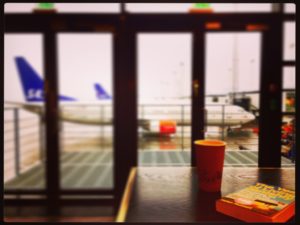
One Comment
Pingback: